• Flaggen
• historische Flaggen
• Bedeutung/Ursprung der Flagge
• Wappen
• Bedeutung/Ursprung des Wappens
• Flugzeugkokarde
• Landkarte
• Zahlen und Fakten
• Geschichte
• Ursprung des Landesnamens
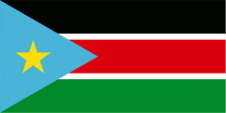
seit 2005,
offiziell,
Nationalflagge,
Seitenverhältnis = 1:2,
Quelle, nach: Wikipedia (EN)



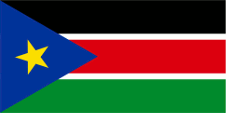
seit 2005,
Variante in der Praxis,
Nationalflagge,
Seitenverhältnis = 1:2,
Quelle, nach: Wikipedia (EN)





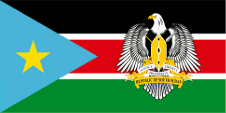
Flagge des Präsidenten,
Seitenverhältnis = 1:2,
Quelle, nach: Wikipedia (EN)




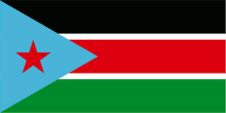
Flagge der SPLM,
Seitenverhältnis = 1:2,
Quelle, nach: Wikipedia (EN)



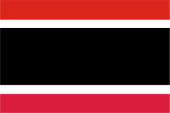
1967–1969,
Flagge der provisorischen Regierung des Südsudan,
Seitenverhältnis = 2:3,
Quelle, nach: World Statesmen




Die Flagge des Südsudan wurde am 09.07.2005 angenommen und zeigt drei horizontale Streifen in Schwarz, Rot und Grün mit schmalen weißen Trennstreifen und ein gleichschenkliges himmelblaues Dreieck mit einem gelben fünfzackigen Stern am Mast. Die Bedeutung der Farben der Flagge ist durch die südsudanesische Regierung festlegt: Schwarz steht für das südsudanesische Volk. Rot steht für das Blut, das für die Unabhängigkeit des Landes vergossen wurde. Grün steht für die Landwirtschaft, den natürlichen Reichtum, das Land und den Fortschritt des Landes. Weiß steht für den Frieden. Blau steht für das Wasser des Nils, eine Quelle des Lebens. Gelb steht für Einheit des Landes und für Hoffnung und Entschlossenheit. Die Farben der Flagge scheinen definiert zu sein, jedoch ließ sich nichts zur rechtlichen Gründlage finden, keine Gesetz und keine Verordnung. Dabei werden die Farben unter anderem im HEX-Farbraum für RBG definiert: Himmelblau = #45B4DB, Gelb = #FCDE02, Rot = #DB0A13 und Grün = #018A2C. Das würde folgenden Farben im Pantone-Farbraum entsprechen: Himmelblau = pt 2985 c, Gelb = Hexachrome Yellow, Rot = pt 1788 c und Grün = pt 355 c. Das Design der Flagge konnte sich bisher wenig durchsetzen, international wird anstelle des Himmelblau meist Dunkelblau verwendet, im Land steht der Stern mal gerade und mal schräg. Vorbild der Flagge war die Flagge der Sudan People's Liberation Movement (SPLM), die als Vorbild ihrer Flagge die Flagge von Kenia angibt. In der ersten Phase des Bürgerkriegs (1955–1972) war eine andere Flagge populär. Diese zeigte fünf horizontale Streifen in Rot, Weiß, Schwarz, Weiß und Rot im Verhältnis 3:1:8:1:3. Diese wurde von 1967 bis 1969 von der provisorischen Regierung des Südsudan verwendet.
Quelle: Wikipedia (EN),
World Statesmen,
Volker Preuß

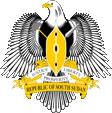
seit 2011,
Wappen von Südsudan,
Quelle: Unknown, vectorisation by Nanin7,
Public domain, via Wikimedia Commons
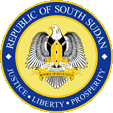
seit 2011,
Siegel von Südsudan,
Quelle: Unknown, vectorisation by Nanin7,
Public domain, via Wikimedia Commons

Das Wappen des Südsudan zeigt einen afrikanischen Fischadler, dessen Brust mit einem Eingeborenenschild bedeckt ist. Dahinter, über Kreuz, eine Schaufel und ein Speer. Spruchbänder in Gold und Silber zeigen den Namen des Landes und das Landesmotto: "Justice, Liberty, Prosperity" → "Gerechtigkeit, Freiheit, Wohlstand". Der Adler steht für Stärke, Widerstandsfähigkeit, Vision und Majestät.
Quelle: Wikipedia (EN)

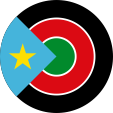
Flugzeugkokarde,
Quelle/Source, nach/by: Wikipedia (EN)

Lage:
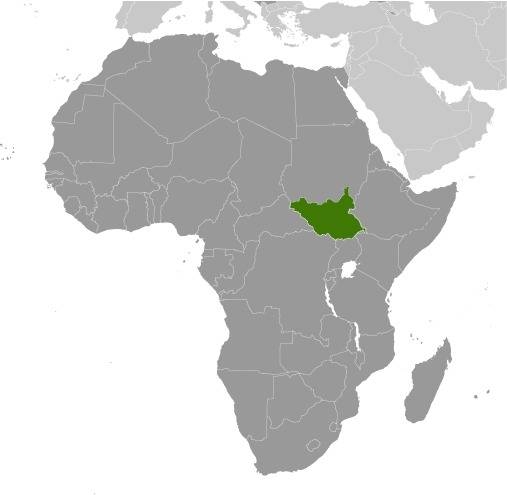
Quelle/Source: CIA World Factbook
Landkarte des Landes:
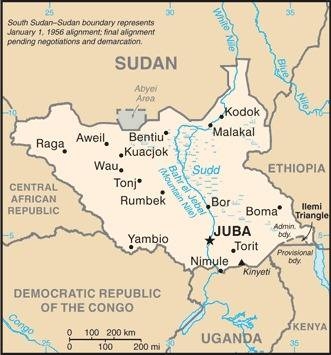
Quelle/Source: CIA World Factbook
interaktive Landkarte des Sudan:
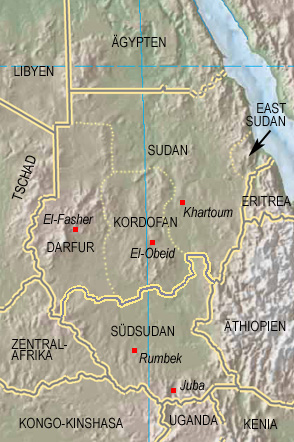
Landkarte/Map: Freeware, University of Texas Libraries,
modyfied by: Volker Preuß

Fläche: 644.329 km²
Einwohner: 11.400.000 (2021), ca. 35-40 % Dinka (Jieng), ca. 15 % Nuer (Naath), ferner: Shilluk (Chollo), Azande, Bari, Kakwa, Kuku, Murle, Mandari, Didinga, Ndogo, Bviri, Lndi, Anuak, Bongo, Lango, Dungotona, Acholi, Baka, Fertit
Religionen: 60.5 % Christen (meist Katholiken und Anglikaner), 32.9 % Animisten, 6.2 % Moslems
Bevölkerungsdichte: 18 Ew./km²
Hauptstadt: Juba (Djuba), 500.000 Ew. (2017)
Amtssprache: Englisch
sonstige Sprachen: Arabisch, nilotische Dialekte, etc.
Währung: 1 Südsudanesisches Pfund (SSP, £SS) = 100 Piaster
Zeitzone: MEZ + 1 h
Quelle:
Wikipedia (D),
CIA World Factbook

ca. 1500 – 1700 · Reich der Fundsch im südlichen Sudan, der Norden wird von den ägyptischen Mameluken abhängig
1863–1875 · Ismail Pasha von Ägypten erobert teilweise den Südsudan und Darfur (1874)
1875–1881 · die Ägypter versuchen den Sklavenhandel zu unterbinden
1881–1898 · antiägyptisch-klerikaler Mahdiaufstand unter der Führung des Mohammed Achmed, genannt Mahdi, Bildung des Mahdireiches
1882 · Großbritannien besetzt Ägypten
1885 · Tod des Mahdi, Nachfolger wird Chalifa Abdullahi
1888–1889 · das Mahdireich attackiert Äthiopien und erobert den Südsudan
1898 · Schlacht von Omdurman, Lord Kitchener vernichtet das Mahdireich
1898 · Schlacht von Faschoda, Lord Kitchener schlägt in den Südsudan eingedrungene Franzosen zurück
1899 · der Sudan wird offiziell von Ägypten und Großbritannien gemeinsam verwaltet (Anglo-Ägyptischer Sudan)
1924 · britische Versuche den Norden und Süden des Sudan getrennt zu verwalten
1955 · der christliche und animistische Südsudan befürchtet in einem unabhängigen Sudan eine nördliche islamische Dominanz und beginnt den zunächst 17 Jahre andauernden Bürgerkrieg
01.01.1956 · Ägypten und Großbritannien gewähren dem Sudan Unabhängigkeit, Republik Sudan
1972 · Abkommen von Addis-Abeba zwischen der Regierung des Sudan und der südsudanesischen Befreiungsfront, vorläufiges Ende des Bürgerkriegs im Süden, Gewährung von Autonomie für den Südsudan
1983 · der Südsudan wird in drei separate Regionen aufgeteilt, Einführung des islamischen Rechts, der Bürgerkrieg im Süden bricht erneut aus
1984 · Verkündung des Ausnahmezustands
1992 · Offensive gegen den Südsudan
1994 · Offensive des Südsudan gegen Regierungstruppen
1996 · Isolierung des Südsudan
1997 · erfolgreiche Offensive der südsudanesischen SPLA (Sudanesische Volksbefreiungsarmee)
12.12.1999 · Verkündung des Ausnahmezustands, Auflösung des Parlaments
2005 · Juba – die Haupstadt des Südsudan – wird von Truppen des Sudan eingenommen, die provisorische Regierung verlegt nach Rumbek
2005 · Friedensabkommen, Ende der Kämpfe, Autonomie für Südsudan
2006 · Juba wird wieder Haupstadt des Südsudan
2008 · erneut Kämpfe zwischen Sudan und Südsudan
09.01.2011 · Beginn einer mehrtägigen Volksabstimmung zur Unabhängigkeit im Südsudan
09.07.2011 · der Südsudan erklärt seine Unabhängigkeit
2013–2018 · Bürgerkrieg (hauptsächlich zwischen Dinka und Nuer)
Quelle:
Atlas zur Geschichte,
World Statesmen,
Wikipedia (EN),
Volker Preuß

Die Christen und Animisten des Südsudan sind in einem der brutalsten und langwierigsten Kämpfe um nationale Unahängigkeit in Afrika mit dem islamischen Norden verwickelt. Der Name "Südsudan" ist ein Kunstbegriff, der sich wie ein einigendes Band um etwa dreißig verschiedene Ethnien im Süden des Sudan bindet. Jede Ethnie hat ihre eigene Miliz und eine eigene Regierung. Die stärkste Rebellengruppe ist jedoch die SPLA (Sudanesische Volksbefreiungsarmee) mit etwa 25 000 Mann, die als Regierungstruppe des Südsudan auftritt. Der Name des Sudan leitet sich von der arabischen Bezeichnung "Bilad es-Sudan" ab. Das heißt "Land der Schwarzen" und bezeichnet eigentlich die ganze Region zwischen Sahara und dem afrikanischen Regenwald von West- bis Ostafrika. In der Antike und im Mittelalter hieß das Land "Nubien", benannt nach den Nubiern, einem afrikanischen Stamm der im Norden des Sudan am Nil lebt.
Quelle: Handbuch der geographischen Namen, Volker Preuß


![]()














![]()
